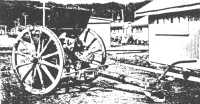The Gun - Mechanisation: Towed Field Artillery | |
Horses!By 1939 mechanisation of field artillery in Britain was virtually complete. However, the artillery of continental armies including those of Germany and Russia remained to a large extent horse-drawn until after World War 2 - despite propaganda to the contrary. As usual New Zealand lagged badly behind Britain in the updating of armed forces' equipment. The last Regular Force equitation course was held late in 1937. In January 1938 recruits of 14 Wing RNZA were informed that 'as the artillery was now mechanised' they would see no horses - but over four months later were still doing gun drill on horse-drawn equipment and had not seen a gun tractor! When the same recruits were posted to Fort Dorset in June 1938 they were asked whether or not they had attended an equitation course! On replying in the negative they were told, 'Well you're going to do one now!' They then underwent sufficient training to enable them to handle and take care of the horses - which were still the station's sole means (officially at least) of moving field guns. Conversion CompletedTo be fair, some progress was being made in the mechanisation process; late in May 1938 the recruits already mentioned were permitted - as a great privilege - to witness the first conversion of field guns from horse to mechanical draught at the Armament and General (A&G) Workshops in Trentham. Guns converted were 18-prs Mk 1 and 2, and 4.5-in howitzers. Conversion involved removing the old wooden wheels, brake gear etc and replacing them with parts from kits made up by the American firm of Martin Parry. Production of these kits came about because the US Army also had numbers of obsolete equipments identical to our 18-prs, except that they had been made to take the French M1897 75-mm ammunition. Each kit consisted basically of two pneumatic-tyred steel disc wheels on stub axles carried on a cranked adapter which fitted over the end of the original axletree. Included were the necessary radius rods, brake gear, layers' seat brackets, etc. Conversion enabled the guns to be safely towed at speeds up to 30 mph (48 kph) on good roads, but increased the preponderance of weight on the trails in action. This was particularly noticeable with the 18-pr, making it rather harder to handle. The limber was also converted by the fitting of similar steel wheels. For some unknown reason it then became known as 'trailer'. | |
 |
QF 18-pr Mk 2 before conversion. The Mk 1, first approved in 1903, was identical to the Mk 2 except it was fitted with a spring recuperator, while the Mk 2 recuperator was hydro-pneumatic. |
| 18-pr Mk 2 after conversion with Martin-Parry kit. |  |
|
Shortly after the outbreak of World War 2 New Zealand received a number of tractors produced by the Marmon-Herrington Co Inc of Indianapolis, USA. These were really commercial-type Ford V8 1-ton trucks with FWD and fitted with seats in rear. Although their cross-country performance was reasonable they were not popular; little space was available, and the open rear was unsatisfactory in bad weather. Both 18-prs, Mk 1 and Mk 2, were superseded by the Mk 4 of 1920 but New Zealand carried on with obsolete equipments until 1941 when 25-prs were received. As World War 2 progressed, the Quad replaced other tractors in the British Commonwealth artilleries. With the end of the 25-pr era the use of the tractor was discontinued. | |
 |
Marmon Herrington tractor hooked in to 18-pr and trailer. |
|
WL Ruffell, 1994 previous | index | next | History index | Home | |